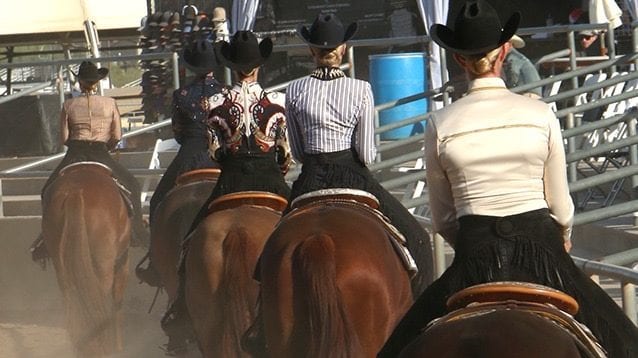A crowded arena is some exhibitors’ worst nightmare. Too much traffic on the rail can turn a great ride into a not-so-great one. GoHorseShow spoke with experienced youth, amateur, and open competitors to get tips and tricks on approaching traffic jams in warm-up arenas and the show pen. We talked to Leigh Berryhill, Beth Clemons, Mo Holmes, Madison Nirenstein, and Bella Rosa about their tips on avoiding traffic jams and getting the best spots in the area.
Keep Your Eyes Up
The number one piece of advice riders gave for navigating traffic jams is to keep your eyes up.
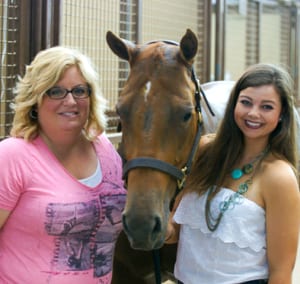 AQHA Professional Horsewoman Leigh Berryhill states, “First, I think you must be a defense rider (driver). I try to have my novice group especially prepared for protecting your horse in both the hunter under saddle and western pleasure. You must keep your eyes up and have a plan in place at all times to stay out of a wreck and get your horse shown to its best in front of the judges.”
AQHA Professional Horsewoman Leigh Berryhill states, “First, I think you must be a defense rider (driver). I try to have my novice group especially prepared for protecting your horse in both the hunter under saddle and western pleasure. You must keep your eyes up and have a plan in place at all times to stay out of a wreck and get your horse shown to its best in front of the judges.”
Amateur Madison Nirenstein agrees, in a rail class, she “keeps tabs on who is in front of me, next to me, and behind me, because if you’re in a huge crowd, but no one is behind you, this is the perfect opportunity to swing wide so that you end up by yourself.”
Mo Holmes echoes Nirenstein’s advice. “The number one mistake I see of beginners is riding with their eyes down and not seeing where they are going or what is going on in front of them.”
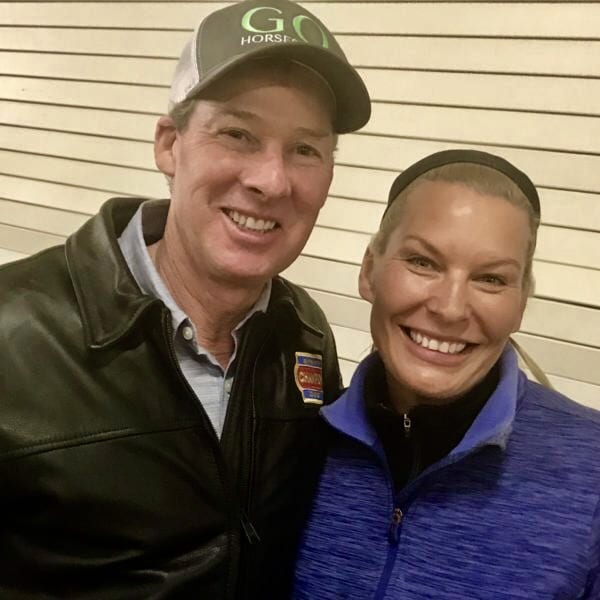 Looking up and monitoring your surroundings in both warm-ups and classes, also helps other riders navigate their horses more effectively. Holmes explains that “by using your eyes and presenting your direction of travel with your head and body language, it allows other riders to predict where you are going and can help others steer around you.”
Looking up and monitoring your surroundings in both warm-ups and classes, also helps other riders navigate their horses more effectively. Holmes explains that “by using your eyes and presenting your direction of travel with your head and body language, it allows other riders to predict where you are going and can help others steer around you.”
Holmes equates rail classes to a NASCAR race, a comparison not often made with a western pleasure class. Holmes elaborates, “Like a NASCAR driver, you have to start reading traffic patterns in front of you and make educated assumptions about where the riders in front and behind you will likely go.”
Multiple Congress champion Bella Rosa agrees, stating, “Going in with a plan is one less thing to worry about when there are lots of people you have to maneuver around.”
Stay Confident, but Not Arrogant
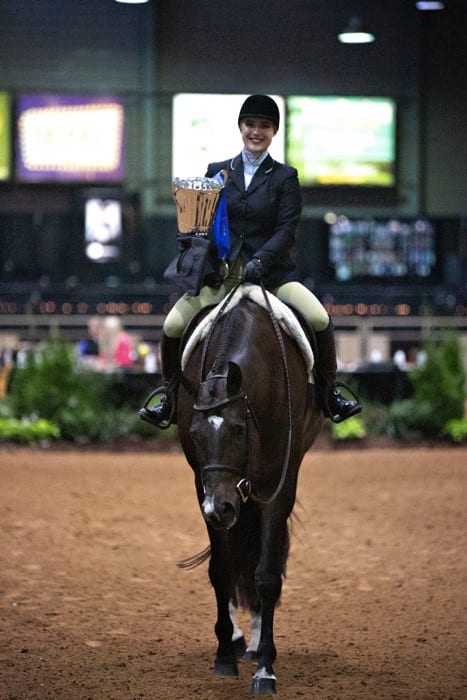 In the show pen, most competitors’ primary goal is to ensure the judges see their horse at its best. A crucial part of that is making sure the judge can see your horse. Nirenstein explains, “I try never to get stuck on the very outside in the hunter under saddle pen because if it’s a big class, you could get hidden by 5 or 6 other horses.”
In the show pen, most competitors’ primary goal is to ensure the judges see their horse at its best. A crucial part of that is making sure the judge can see your horse. Nirenstein explains, “I try never to get stuck on the very outside in the hunter under saddle pen because if it’s a big class, you could get hidden by 5 or 6 other horses.”
However, Madison stresses that the quest to ensure you are seen should never result in sloppy sportsmanship. She says, “In the arena, never cut someone off. One of the biggest differences I notice between some of the novice classes and regular amateurs is managing traffic effectively and not ruining someone else’s ride to get seen.”
Know Your Horse
Professional trainer Beth Clemons says, “My tip is to have a plan and practice at home. At home, practice getting your horse on and off the rail while keeping their body position and continuing to show. Get just as comfortable at home with passing as you are with your transitions.”
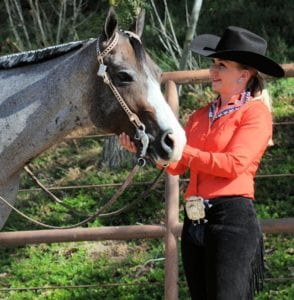 Clemons continues, “Also, don’t be afraid to speak up. If someone is passing you and starts coming into your space too soon, softly ask them to give you a little more space. Have a plan for your reverse as well. If the horse in front of you just passed, you may want to plan to get behind it in reverse so you don’t get covered up or risk being cut off. Practice, practice, practice is my biggest advice.”
Clemons continues, “Also, don’t be afraid to speak up. If someone is passing you and starts coming into your space too soon, softly ask them to give you a little more space. Have a plan for your reverse as well. If the horse in front of you just passed, you may want to plan to get behind it in reverse so you don’t get covered up or risk being cut off. Practice, practice, practice is my biggest advice.”
Ensuring you can trust your horse to listen as you navigate them through a traffic jam is essential to avoiding disaster. “You must be sure that you have the buttons to rate your horse’s pace, be it a comeback or a push forward,” Holmes explains. “You want to do this as subtly as possible, so that your cues go unnoticed in the ring and you look seamless with your horse.”
Holmes emphasizes that riders need to assess the other horses in pen and position themselves to their best advantage. For example, knowing how big or slow your horse’s stride is can help guide your decisions on the rail.
Mo says, “Ideally, you want to create a space for yourself to show off to the judge, so that may mean going deep when everyone else is cutting a corner, or vice versa. Also, use your departure times wisely and to your advantage to either allow traffic to pull away from you or so that you put traffic safely behind you, depending upon the situation.”
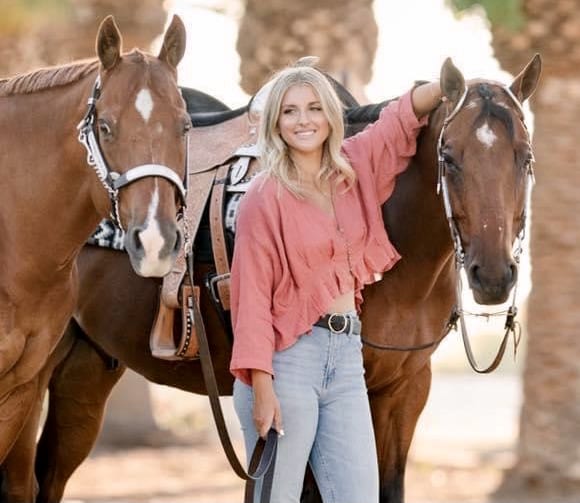 Rosa elaborates, explaining how her two horses handle crowded pens differently. Knowing how to adjust to their needs helps her succeed. “My horse is very calm in crowded pens, so I usually don’t have to worry about him. However, my other horse can get pretty anxious, so I find the best way to keep him calm in a crowded pen is to take my time with everything, be effective, and then be done,” says Bella. “Of course, lots of walk breaks and pets help too.”
Rosa elaborates, explaining how her two horses handle crowded pens differently. Knowing how to adjust to their needs helps her succeed. “My horse is very calm in crowded pens, so I usually don’t have to worry about him. However, my other horse can get pretty anxious, so I find the best way to keep him calm in a crowded pen is to take my time with everything, be effective, and then be done,” says Bella. “Of course, lots of walk breaks and pets help too.”
Smiles Go a Long Way
A common theme throughout all of our interviews was: we all make mistakes. “We were all beginners once, and we were all once nervous and didn’t know all the rules,” Holmes reassures. Riders can never go wrong with asking questions and giving others space as much as possible.
Nirenstein agrees, explaining further that “if you run into someone or get too close to someone in the warm-up pen, apologize.” A ‘thank you’ or an ‘I’m sorry’ can go a long way if you make a mistake in a warm-up pen. Keep your eyes up, smile, and be polite. Holmes agrees, “Horse shows should be fun and not nerve-wracking.”


